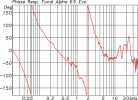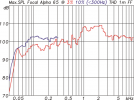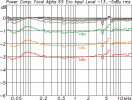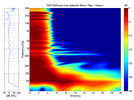This is a review and detailed measurements of the Focal Alpha 65 EVO powered monitor (speaker). I purchased it recently for US $404 from Amazon (with kind support from members).
I like the look and feel of this monitor:

It has a very wide stance for this size speaker which likely helps with bass response. Also helping is that very oversized front port which helps as place to grab and move it.
The side panel shows a nice design touch, setting the Alpha 65 apart from myriad of other powered monitors:

Notice the interesting shallow waveguide around the tweeter.
Back panel is rather simple:

I wish the LF and HF controls had a center detent. I adjusted them by eye but I think I set the treble one a hair too high per measurements below.
Amplification noise from the tweeter is very low. I could barely hear it from an inch or two.
Measurements that you are about to see were performed using the Klippel Near-field Scanner (NFS). This is a robotic measurement system that analyzes the speaker all around and is able (using advanced mathematics and dual scan) to subtract room reflections (so where I measure it doesn't matter). It also measures the speaker at close distance ("near-field") which sharply reduces the impact of room noise. Both of these factors enable testing in ordinary rooms yet results that can be more accurate than an anechoic chamber. In a nutshell, the measurements show the actual sound coming out of the speaker independent of the room.
Measurements are compliant with latest speaker research into what can predict the speaker preference and is standardized in CEA/CTA-2034 ANSI specifications. Likewise listening tests are performed per research that shows mono listening is much more revealing of differences between speakers than stereo or multichannel.
Reference axis was the center of the tweeter (aligned by eye). It is getting colder with the measurement room temp at 14 degrees C. Accuracy is better than 1% for almost entire audio spectrum indicating a well designed speaker.
Focal Alpha 65 EVO Measurements
Acoustic measurements can be grouped in a way that can be perceptually analyzed to determine how good a speaker is and how it can be used in a room. This so called spinorama shows us just about everything we need to know about the speaker with respect to tonality and some flaws:

While there are fair number of fine ups and downs, overall on-axis response is flat and extends down to nearly 40 Hz which is impressive for such a low cost and small speaker. As I noted in the intro, the HF control may needed to be set a bit lower to flatten the response a bit more. The chewiness I expected from the front port of such designs is there but is very well controlled as we see in near-field measurements:

Our early window and predicted in-room response are for far field but still instructive:


Because the waveguide is so shallow, horizontal beam width is impressively wide:


Tonality should be a lot more consistent as you shift left and right.
Vertical response is good for the design type:

Now we get to a real puzzle: the distortion measurements:


I don't know what is going on between 1.5 and 8 kHz. Yes, it is distorting at 86 dBSPL but why did it do less at 96 dBSPL? Did a limiter kick in? Or is it sensitive to that 86 dBSPL playback level? To be sure, I re-ran the 86 dBSPL distortion after I ran the 96 and it produces the same elevated results. Very strange.
Edit: I contacted the company and they immediately responded and sent me a sample. Alas, a bunch of things interfered with me testing it until today. I am pleased to say that the distortion problem above is not there in sample 2:

As you see I repeated the measurement on my review sample (left) and confirmed problem is still there in identical setup where the new sample (right) has none of it. Indeed it actually has extremely low distortion now. I will be sending my sample back to them for investigation. There is also reduction in tweeter distortion at 96 dBSPL:

CSD waterfall measurements show very persistent resonances so perhaps that is the cause:

Here is the impulse response:

Focal Alpha 65 EVO Listening Tests
Contrary to my normal routine, I listened to the Alpha 65 in the near-field prior to computing the measurement results. Immediate impression was very positive with warm sound courtesy of good bass which did not bottom out no matter how much I pushed it. It ignores sub-bass but the part of it that it did play was very clean and not subject to distortion.
I tried to identify distortion in the treble per measurements but I could not. It may very well be there but it is not like you can turn it on and off and hear the effect.
EDIT: as noted in the review now, I received a second sample from the company it does not have the distortion problem.
I did not feel the need for any equalization. The overall signature was maybe a tad bright which I would fix using the rear control.
Conclusions
I really like the look, feel and the sound of the Alpha 65. It innovated with a wider form factor which gives it much stronger bass than a small budget monitor usually produces. It doesn't generate much tweeter noise which is nice.Had it not been for the distortion that I measured, it would have garnered one of my highest recommendations.
I am happy to strongly recommend the Focal Alpha 65 EVO. A brand name speaker with this level of overall performance at this price is impressive.
----------
As always, questions, comments, recommendations, etc. are welcome.
Any donations are much appreciated using: https://www.audiosciencereview.com/forum/index.php?threads/how-to-support-audio-science-review.8150/
I like the look and feel of this monitor:
It has a very wide stance for this size speaker which likely helps with bass response. Also helping is that very oversized front port which helps as place to grab and move it.
The side panel shows a nice design touch, setting the Alpha 65 apart from myriad of other powered monitors:
Notice the interesting shallow waveguide around the tweeter.
Back panel is rather simple:
I wish the LF and HF controls had a center detent. I adjusted them by eye but I think I set the treble one a hair too high per measurements below.
Amplification noise from the tweeter is very low. I could barely hear it from an inch or two.
Measurements that you are about to see were performed using the Klippel Near-field Scanner (NFS). This is a robotic measurement system that analyzes the speaker all around and is able (using advanced mathematics and dual scan) to subtract room reflections (so where I measure it doesn't matter). It also measures the speaker at close distance ("near-field") which sharply reduces the impact of room noise. Both of these factors enable testing in ordinary rooms yet results that can be more accurate than an anechoic chamber. In a nutshell, the measurements show the actual sound coming out of the speaker independent of the room.
Measurements are compliant with latest speaker research into what can predict the speaker preference and is standardized in CEA/CTA-2034 ANSI specifications. Likewise listening tests are performed per research that shows mono listening is much more revealing of differences between speakers than stereo or multichannel.
Reference axis was the center of the tweeter (aligned by eye). It is getting colder with the measurement room temp at 14 degrees C. Accuracy is better than 1% for almost entire audio spectrum indicating a well designed speaker.
Focal Alpha 65 EVO Measurements
Acoustic measurements can be grouped in a way that can be perceptually analyzed to determine how good a speaker is and how it can be used in a room. This so called spinorama shows us just about everything we need to know about the speaker with respect to tonality and some flaws:
While there are fair number of fine ups and downs, overall on-axis response is flat and extends down to nearly 40 Hz which is impressive for such a low cost and small speaker. As I noted in the intro, the HF control may needed to be set a bit lower to flatten the response a bit more. The chewiness I expected from the front port of such designs is there but is very well controlled as we see in near-field measurements:
Our early window and predicted in-room response are for far field but still instructive:
Because the waveguide is so shallow, horizontal beam width is impressively wide:
Tonality should be a lot more consistent as you shift left and right.
Vertical response is good for the design type:
Now we get to a real puzzle: the distortion measurements:
Edit: I contacted the company and they immediately responded and sent me a sample. Alas, a bunch of things interfered with me testing it until today. I am pleased to say that the distortion problem above is not there in sample 2:
As you see I repeated the measurement on my review sample (left) and confirmed problem is still there in identical setup where the new sample (right) has none of it. Indeed it actually has extremely low distortion now. I will be sending my sample back to them for investigation. There is also reduction in tweeter distortion at 96 dBSPL:
CSD waterfall measurements show very persistent resonances so perhaps that is the cause:
Here is the impulse response:
Focal Alpha 65 EVO Listening Tests
Contrary to my normal routine, I listened to the Alpha 65 in the near-field prior to computing the measurement results. Immediate impression was very positive with warm sound courtesy of good bass which did not bottom out no matter how much I pushed it. It ignores sub-bass but the part of it that it did play was very clean and not subject to distortion.
EDIT: as noted in the review now, I received a second sample from the company it does not have the distortion problem.
I did not feel the need for any equalization. The overall signature was maybe a tad bright which I would fix using the rear control.
Conclusions
I really like the look, feel and the sound of the Alpha 65. It innovated with a wider form factor which gives it much stronger bass than a small budget monitor usually produces. It doesn't generate much tweeter noise which is nice.
I am happy to strongly recommend the Focal Alpha 65 EVO. A brand name speaker with this level of overall performance at this price is impressive.
----------
As always, questions, comments, recommendations, etc. are welcome.
Any donations are much appreciated using: https://www.audiosciencereview.com/forum/index.php?threads/how-to-support-audio-science-review.8150/
Attachments
Last edited:























